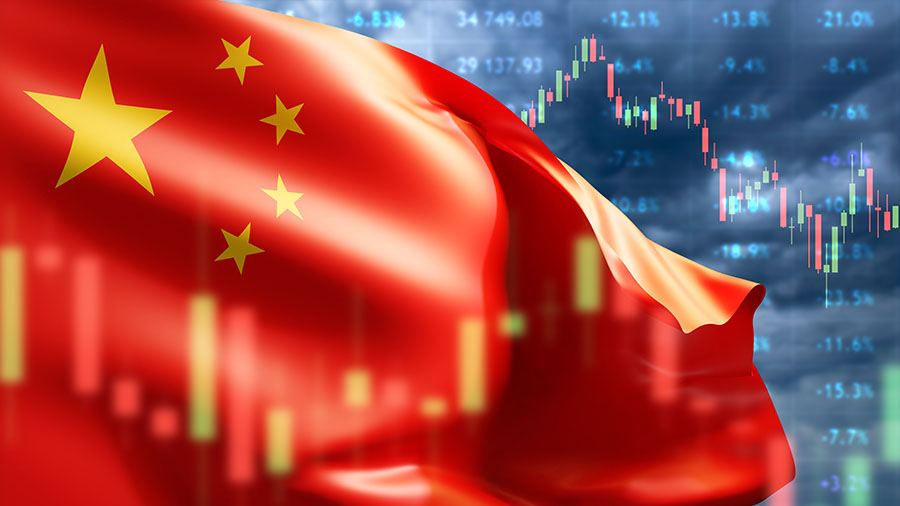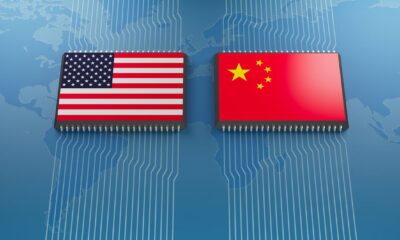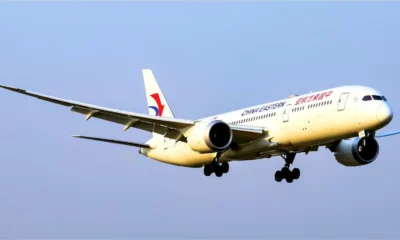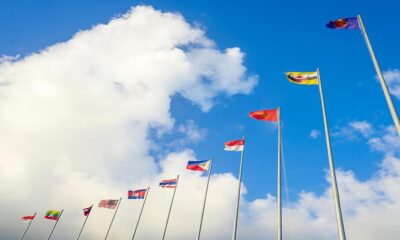China
China Hands Out Punishment After Airlines’ Bizarre Mid-Air Stand-Off
Reuters A passenger jet flies towards Hongqiao Airport in Shanghai August 23, 2011. More In airlines Air Tickets Regain Altitude as High Speed Rail Line Runs Late Video: Now Boarding – Tokyo to Taipei Real Orders for Chinese Commercial Jet? The Great Disturbance in China’s Airspace: Private Jets Congested Airport May Hurt Air China And you thought driving in China was treacherous . The country’s General Administration of Civil Aviation on Monday announced its punishment for privately held Juneyao Airlines Co. after an incident earlier this month in the skies above Shanghai in which a Juneyao flight crew refused to give way to a Qatar Airways jet that had issued a “mayday” call and requested immediate permission to land as it ran low on fuel. Juneyao, one of relatively few private carriers in an industry dominated by state-run airlines, was ordered to reduce its flight capacity by 10% and temporarily barred from going ahead with expansion plans as well as hiring foreign pilots. Officials also banned the flight’s captain, a South Korean citizen, from continuing work as a pilot in China, the state-run Xinhua news agency reported. The Qatar Airways flight, a Boeing 777 en route from Doha, had been circling above Shanghai Pudong International Airport due to bad weather, Xinhua reported. Authorities decided to divert it to the city’s smaller Hongqiao International Airport as it ran low on fuel. The Juneyao pilot refused six orders from the control tower to yield and allow the Qatari jet to land first. Both flights eventually landed safely, but the Civil Aviation Administration said the Qatar jet had only about 18 minutes worth of fuel left when it finally landed at Hongqiao. Juneyao Airlines in a statement posted to its website on Tuesday, said it “would seriously draw lessons” from the case, and said the airline took responsibility for the incident. The Civil Aviation Administration statement said China would discuss with Qatari authorities whether the Qatar Airways crew could have done a better job predicting the fuel problem. China’s private airlines in have struggled to gain market share against state-owned airline giants such as Air China Ltd., China Southern Airlines Co. and China Eastern Airlines Corp. The growing woes of high-speed rail in China, which have been plagued by concerns over safety in the aftermath of a deadly accident in eastern China last month, are breathing new life into regional air routes in China. Domestic airlines had steeply discounted regional flights in June as the much-touted Beijing-Shanghai high-speed rail line prepared to open. But ticket prices have since returned to normal amid delays and safety concerns on the high-speed tracks . For his part, the Juneyao pilot claimed he’d also been running low of fuel, though the Civil Aviation Administration statement said his jet still had about 40 minutes left in fuel when it landed. “No matter the reason, it was wrong for the crew members of flight HO1112 not to carry out the instructions of air traffic controllers on Aug. 13,” the company said according to Xinhua. –Brian Spegele. Follow him on Twitter @bspegele .

- Reuters
- A passenger jet flies towards Hongqiao Airport in Shanghai August 23, 2011.
And you thought driving in China was treacherous.
The country’s General Administration of Civil Aviation on Monday announced its punishment for privately held Juneyao Airlines Co. after an incident earlier this month in the skies above Shanghai in which a Juneyao flight crew refused to give way to a Qatar Airways jet that had issued a “mayday” call and requested immediate permission to land as it ran low on fuel.
Juneyao, one of relatively few private carriers in an industry dominated by state-run airlines, was ordered to reduce its flight capacity by 10% and temporarily barred from going ahead with expansion plans as well as hiring foreign pilots. Officials also banned the flight’s captain, a South Korean citizen, from continuing work as a pilot in China, the state-run Xinhua news agency reported.
The Qatar Airways flight, a Boeing 777 en route from Doha, had been circling above Shanghai Pudong International Airport due to bad weather, Xinhua reported. Authorities decided to divert it to the city’s smaller Hongqiao International Airport as it ran low on fuel. The Juneyao pilot refused six orders from the control tower to yield and allow the Qatari jet to land first. Both flights eventually landed safely, but the Civil Aviation Administration said the Qatar jet had only about 18 minutes worth of fuel left when it finally landed at Hongqiao.
Juneyao Airlines in a statement posted to its website on Tuesday, said it “would seriously draw lessons” from the case, and said the airline took responsibility for the incident. The Civil Aviation Administration statement said China would discuss with Qatari authorities whether the Qatar Airways crew could have done a better job predicting the fuel problem.
China’s private airlines in have struggled to gain market share against state-owned airline giants such as Air China Ltd., China Southern Airlines Co. and China Eastern Airlines Corp.
The growing woes of high-speed rail in China, which have been plagued by concerns over safety in the aftermath of a deadly accident in eastern China last month, are breathing new life into regional air routes in China. Domestic airlines had steeply discounted regional flights in June as the much-touted Beijing-Shanghai high-speed rail line prepared to open. But ticket prices have since returned to normal amid delays and safety concerns on the high-speed tracks.
For his part, the Juneyao pilot claimed he’d also been running low of fuel, though the Civil Aviation Administration statement said his jet still had about 40 minutes left in fuel when it landed.
“No matter the reason, it was wrong for the crew members of flight HO1112 not to carry out the instructions of air traffic controllers on Aug. 13,” the company said according to Xinhua.
–Brian Spegele. Follow him on Twitter @bspegele.
In recent years, China has re-invigorated its support for leading state-owned enterprises in sectors it considers important to “economic security,” explicitly looking to foster globally competitive national champions.
In 2006, China announced that by 2010 it would decrease energy intensity 20% from 2005 levels.
The government has also focused on foreign trade as a major vehicle for economic growth.
Nevertheless, key bottlenecks continue to constrain growth.
Technology, labor productivity, and incomes have advanced much more rapidly in industry than in agriculture.
The technological level and quality standards of its industry as a whole are still fairly low, notwithstanding a marked change since 2000, spurred in part by foreign investment.
The market-oriented reforms China has implemented over the past two decades have unleashed individual initiative and entrepreneurship, whilst retaining state domination of the economy.
Globally, foreign investment decreased by almost 40 percent last year amid the financial downturn and is expected to show only marginal growth this year.
From January to June, the ODI in financial sectors was up by 44 percent to $17.9 billion, and in July alone, the ODI recorded $8.91 billion, the highest this year.
It also aims to sell more than 15 million of the most fuel-efficient vehicles in the world each year by then.
China’s challenge in the early 21st century will be to balance its highly centralized political system with an increasingly decentralized economic system.
Agriculture is by far the leading occupation, involving over 50% of the population, although extensive rough, high terrain and large arid areas – especially in the west and north – limit cultivation to only about 10% of the land surface.
China is the world’s largest producer of rice and wheat and a major producer of sweet potatoes, sorghum, millet, barley, peanuts, corn, soybeans, and potatoes.
Fish and pork supply most of the animal protein in the Chinese diet.
Coal is the most abundant mineral (China ranks first in coal production); high-quality, easily mined coal is found throughout the country, but especially in the north and northeast.
China’s leading export minerals are tungsten, antimony, tin, magnesium, molybdenum, mercury, manganese, barite, and salt.
Coal is the single most important energy source in China; coal-fired thermal electric generators provide over 70% of the country’s electric power.
The east and northeast are well served by railroads and highways, and there are now major rail and road links with the interior.
More here:
China Hands Out Punishment After Airlines’ Bizarre Mid-Air Stand-Off
Business
China Limits Apple Operations as BYD Manufacturing Moves to India and Southeast Asia Amid Trade Frictions | International Business News – The Times of India

China is restricting the export of high-tech manufacturing equipment and personnel to India and Southeast Asia, aiming to maintain domestic production amid potential US tariffs, impacting companies like Foxconn and BYD.
China Curbs on High-Tech Manufacturing
China is intensifying restrictions on the movement of employees and specialized equipment essential for high-tech manufacturing in India and Southeast Asia. This measure aims to prevent companies from relocating production due to potential tariffs under the incoming US administration. Beijing has urged local governments to restrict technology transfers and export of manufacturing tools as part of this strategy.
Impact on Foxconn and Apple’s Strategy
Foxconn, Apple’s primary assembly partner, is facing challenges in sending staff and receiving equipment in India, which could impact production. Despite these hurdles, current manufacturing operations remain unaffected. The Chinese government insists it treats all nations equally while reinforcing its domestic production to mitigate job losses and retain foreign investments.
Broader Implications for India
Additionally, these restrictions affect electric vehicle and solar panel manufacturers in India, notably BYD and Waaree Energies. Although the measures are not explicitly targeting India, they complicate the business landscape. As foreign companies seek alternatives to China, these developments are likely to reshape manufacturing strategies amidst ongoing geopolitical tensions.
China
China’s GDP Grows 5% in 2024: Key Insights and Main Factors

In 2024, China’s GDP grew by 5.0%, meeting its annual target. The fourth quarter saw a 5.4% increase, driven by exports and stimulus measures. The secondary industry grew 5.3%, while the tertiary increased by 5.0%, totaling RMB 134.91 trillion.
China’s GDP grew by 5.0 percent in in 2024, meeting the government’s annual economic target set at the beginning of the year. Fourth-quarter GDP exceeded expectations, rising by 5.4 percent, driven by exports and a flurry of stimulus measures. This article provides a brief overview of the key statistics and the main drivers behind this growth.
According to official data released by the National Bureau of Statistics (NBS) on January 17, 2025, China’s GDP reached RMB 134.91 trillion (US$18.80 trillion) in 2024, reflecting a 5.0 percent year-on-year growth at constant prices. During the 2024 Two Sessions, the government set the 2024 GDP growth target of “around 5 percent”.
By sector, the secondary industry expanded by 5.3 percent year-on-year to RMB 49.21 trillion (US$6.85 trillion), the fastest among the three sectors, while the tertiary industry grew by 5.0 percent, reaching RMB 76.56 trillion (US$10.63 trillion) and the primary industry contributed RMB 9.14 trillion (US$1.31 trillion), growing 3.5 percent.
A more detailed analysis of China’s economic performance in 2024 will be provided later.
(1USD = 7.1785 RMB)
| This article was first published by China Briefing , which is produced by Dezan Shira & Associates. The firm assists foreign investors throughout Asia from offices across the world, including in in China, Hong Kong, Vietnam, Singapore, and India . Readers may write to info@dezshira.com for more support. |
Read the rest of the original article.
China
Can science be both open and secure? Nations grapple with tightening research security as China’s dominance grows

The U.S.-China science agreement renewal narrows collaboration scopes amid security concerns, highlighting tensions. Nations fear espionage, hindering vital international partnerships essential for scientific progress. Openness risks declining.
Amid heightened tensions between the United States and China, the two countries signed a bilateral science and technology agreement on Dec. 13, 2024. The event was billed as a “renewal” of a 45-year-old pact to encourage cooperation, but that may be misleading.
The revised agreement drastically narrows the scope of the original agreement, limits the topics allowed to be jointly studied, closes opportunities for collaboration and inserts a new dispute resolution mechanism.
This shift is in line with growing global concern about research security. Governments are worried about international rivals gaining military or trade advantages or security secrets via cross-border scientific collaborations.
The European Union, Canada, Japan and the United States unveiled sweeping new measures within months of each other to protect sensitive research from foreign interference. But there’s a catch: Too much security could strangle the international collaboration that drives scientific progress.
As a policy analyst and public affairs professor, I research international collaboration in science and technology and its implications for public and foreign policy. I have tracked the increasingly close relationship in science and technology between the U.S. and China. The relationship evolved from one of knowledge transfer to genuine collaboration and competition.
Now, as security provisions change this formerly open relationship, a crucial question emerges: Can nations tighten research security without undermining the very openness that makes science work?
Chinese Premier Deng Xiaoping and American President Jimmy Carter sign the original agreement on cooperation in science and technology in 1979.
Dirck Halstead/Hulton Archive via Getty Images
China’s ascent changes the global landscape
China’s rise in scientific publishing marks a dramatic shift in global research. In 1980, Chinese authors produced less than 2% of research articles included in the Web of Science, a curated database of scholarly output. By my count, they claimed 25% of Web of Science articles by 2023, overtaking the United States and ending its 75-year reign at the top, which had begun in 1948 when it surpassed the United Kingdom.
In 1980, China had no patented inventions. By 2022, Chinese companies led in U.S. patents issued to foreign companies, receiving 40,000 patents compared with fewer than 2,000 for U.K. companies. In the many advanced fields of science and technology, China is at the world frontier, if not in the lead.
Since 2013, China has been the top collaborator in science with the United States. Thousands of Chinese students and scholars have conducted joint research with U.S. counterparts.
Most American policymakers who championed the signing of the 1979 bilateral agreement thought science would liberalize China. Instead, China has used technology to shore up autocratic controls and to build a strong military with an eye toward regional power and global influence.
Leadership in science and technology wins wars and builds successful economies. China’s growing strength, backed by a state-controlled government, is shifting global power. Unlike open societies where research is public and shared, China often keeps its researchers’ work secret while also taking Western technology through hacking, forced technology transfers and industrial espionage. These practices are why many governments are now implementing strict security measures.
Nations respond
The FBI claims China has stolen sensitive technologies and research data to build up its defense capabilities. The China Initiative under the Trump administration sought to root out thieves and spies. The Biden administration did not let up the pressure. The 2022 Chips and Science Act requires the National Science Foundation to establish SECURE – a center to aid universities and small businesses in helping the research community make security-informed decisions. I am working with SECURE to evaluate the effectiveness of its mission.
Other advanced nations are on alert, too. The European Union is advising member states to boost security measures. Japan joined the United States in unveiling sweeping new measures to protect sensitive research from foreign interference and exploitation. European nations increasingly talk about technological sovereignty as a way to protect against exploitation by China. Similarly, Asian nations are wary of China’s intentions when it seeks to cooperate.
Australia has been especially vocal about the threat posed by China’s rise, but others, too, have issued warnings. The Netherlands issued a policy for secure international collaboration. Sweden raised the alarm after a study showed how spies had exploited its universities.
Canada has created the Research Security Centre for public safety and, like the U.S., has established regionally dispersed advisers to provide direct support to universities and researchers. Canada now requires mandatory risk assessment for research partnerships involving sensitive technologies. Similar approaches are underway in Australia and the U.K.
Germany’s 2023 provisions establish compliance units and ethics committees to oversee security-relevant research. They are tasked with advising researchers, mediating disputes and evaluating the ethical and security implications of research projects. The committees emphasize implementing safeguards, controlling access to sensitive data and assessing potential misuse.
Japan’s 2021 policy requires researchers to disclose and regularly update information regarding their affiliations, funding sources – both domestic and international – and potential conflicts of interest. A cross-ministerial R&D management system is unrolling seminars and briefings to educate researchers and institutions on emerging risks and best practices for maintaining research security.
The Organisation for Economic Co-operation and Development keeps a running database with more than 206 research security policy statements issued since 2022.
Emmanuelle Charpentier, left, from France, and Jennifer Doudna, from the U.S., shared the Nobel Prize in chemistry in 2020 for their joint research.
Miguel RiopaI/AFP via Getty Images
Openness waning
Emphasis on security can strangle the international collaboration that drives scientific progress. As much as 25% of all U.S. scientific articles result from international collaboration. Evidence shows that international engagement and openness produce higher-impact research. The most elite scientists work across national borders.
Even more critically, science depends on the free flow of ideas and talent across borders. After the Cold War, scientific advancement accelerated as borders opened. While national research output remained flat in recent years, international collaborations showed significant growth, revealing science’s increasingly global nature.
The challenge for research institutions will be implementing these new requirements without creating a climate of suspicion or isolation. Retrenchment to national borders could slow progress. Some degree of risk is inherent in scientific openness, but we may be coming to the end of a global, collaborative era in science.
This article is republished from The Conversation under a Creative Commons license. Read the original article.












